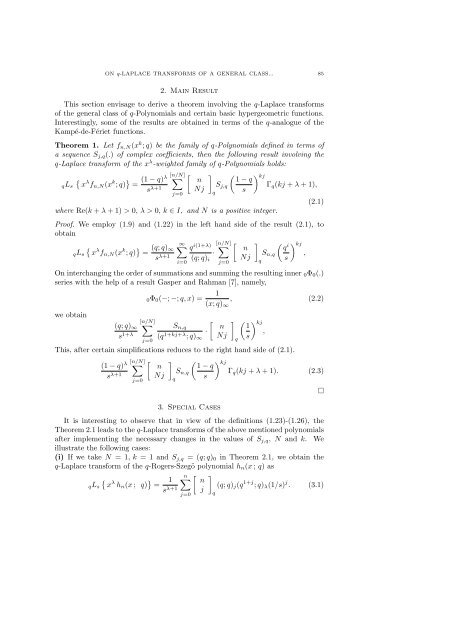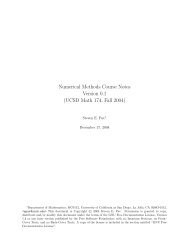88 ON q-LAPLACE TRANSFORMS OF A GENERAL CLASS OF q ...
88 ON q-LAPLACE TRANSFORMS OF A GENERAL CLASS OF q ...
88 ON q-LAPLACE TRANSFORMS OF A GENERAL CLASS OF q ...
Create successful ePaper yourself
Turn your PDF publications into a flip-book with our unique Google optimized e-Paper software.
<strong>ON</strong> q-<strong>LAPLACE</strong> <strong>TRANSFORMS</strong> <strong>OF</strong> A <strong>GENERAL</strong> <strong>CLASS</strong>... 85<br />
2. Main Result<br />
This section envisage to derive a theorem involving the q-Laplace transforms<br />
of the general class of q-Polynomials and certain basic hypergeometric functions.<br />
Interestingly, some of the results are obtained in terms of the q-analogue of the<br />
Kampé-de-Fériet functions.<br />
Theorem 1. Let f n,N (x k ; q) be the family of q-Polynomials defined in terms of<br />
a sequence S j,q (.) of complex coefficients, then the following result involving the<br />
q-Laplace transform of the x λ -weighted family of q-Polynomials holds:<br />
{<br />
qL s x λ f n,N (x k ; q) } [n/N]<br />
(1 − q)λ ∑<br />
[ ] ( ) kj<br />
n 1 − q<br />
=<br />
s λ+1<br />
S<br />
Nj j,q Γ q (kj + λ + 1),<br />
j=0<br />
q<br />
s<br />
(2.1)<br />
where Re(k + λ + 1) > 0, λ > 0, k ∈ I, and N is a positive integer.<br />
Proof. We employ (1.9) and (1.22) in the left hand side of the result (2.1), to<br />
obtain<br />
{<br />
qL s x λ f n,N (x k ; q) } = (q; q) ∑ ∞<br />
∞ q i(1+λ) [n/N]<br />
∑<br />
[ ] ( )<br />
n q<br />
i kj<br />
s λ+1<br />
·<br />
S<br />
(q; q) i Nj n,q ,<br />
q<br />
s<br />
i=0<br />
On interchanging the order of summations and summing the resulting inner 0 Φ 0 (.)<br />
series with the help of a result Gasper and Rahman [7], namely,<br />
we obtain<br />
(q; q) ∞<br />
s 1+λ<br />
0Φ 0 (−; −; q, x) =<br />
[n/N]<br />
∑<br />
j=0<br />
j=0<br />
S n,q<br />
(q 1+kj+λ ; q) ∞<br />
·<br />
[<br />
n<br />
Nj<br />
1<br />
(x; q) ∞<br />
, (2.2)<br />
]<br />
q<br />
( 1<br />
s<br />
) kj<br />
,<br />
This, after certain simplifications reduces to the right hand side of (2.1).<br />
(1 − q) λ [n/N]<br />
∑<br />
[ ] ( ) kj<br />
n 1 − q<br />
s λ+1<br />
S<br />
Nj n,q Γ q (kj + λ + 1). (2.3)<br />
q<br />
s<br />
j=0<br />
3. Special Cases<br />
It is interesting to observe that in view of the definitions (1.23)-(1.26), the<br />
Theorem 2.1 leads to the q-Laplace transforms of the above mentioned polynomials<br />
after implementing the necessary changes in the values of S j,q , N and k. We<br />
illustrate the following cases:<br />
(i) If we take N = 1, k = 1 and S j,q = (q; q) 0 in Theorem 2.1, we obtain the<br />
q-Laplace transform of the q-Rogers-Szegö polynomial h n (x ; q) as<br />
{<br />
qL s x λ h n (x ; q) } = 1 ∑ n [ ]<br />
n<br />
s λ+1<br />
(q; q)<br />
j<br />
j (q 1+j ; q) λ (1/s) j . (3.1)<br />
q<br />
j=0<br />
□














